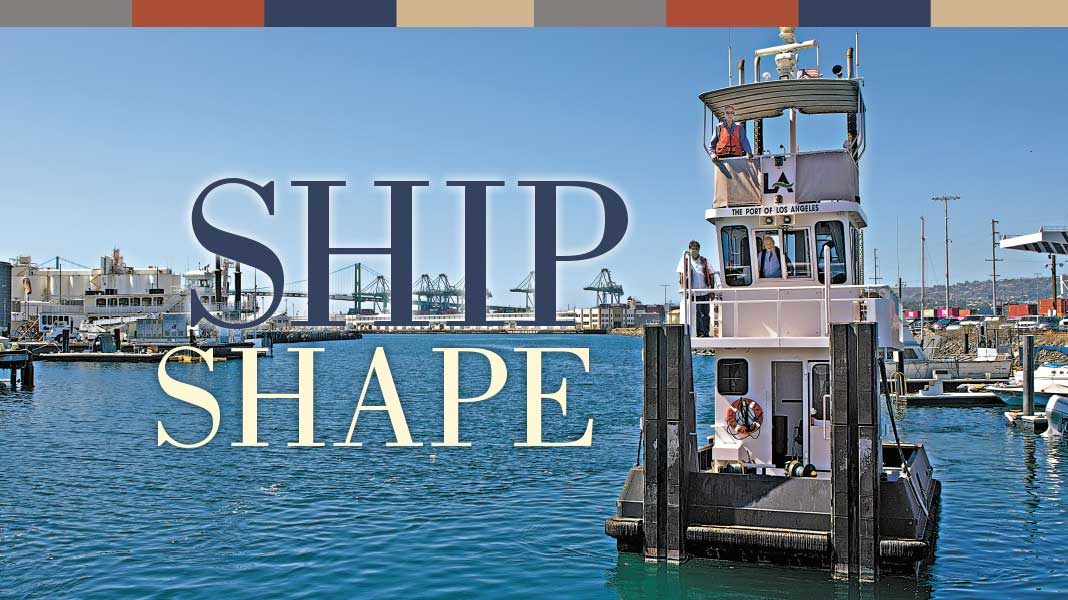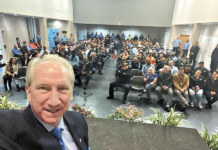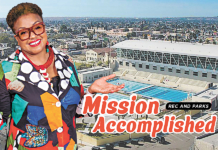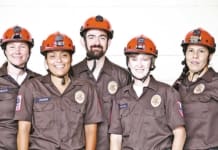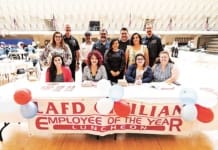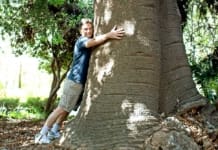Photos by Summy Lam, Director of Marketing, and John Burnes, Alive! editor.
 One of the world’s largest ports needs a lot of services to keep it running smoothly – police, fire, construction, engineering, security … and sometimes simply moving things from A to B.
One of the world’s largest ports needs a lot of services to keep it running smoothly – police, fire, construction, engineering, security … and sometimes simply moving things from A to B.

That’s what Vessel Operations is all about. Vessel Operations, formed in 2010 as part of Construction and Maintenance, uses its two tugs, barges, platforms, cranes and other equipment to move things as needed, and to keep things tidy.
The department does a lot of work transporting the piles that get driven into the ground to form docks. It also works with the Equipment Operations Division to maintain the Harbor’s numerous safety ladders.
In this month’s feature, read about all that they do, and the pride they take in helping keep the critically important Port running smoothly.


Mission: Move the Piles
On Sept. 19, the Alive! crew – Club CEO John Hawkins, Club Director of Marketing Summy Lam, and Alive! editor John Burnes – were invited to tag along as Vessel Operations took on a normal, everyday mission: move the department’s un-motored derrick (tall crane) barge and a shipment of tall wooden piles (like telephone poles) from the Construction and Maintenance dock to another dock 30 minutes away in another part of the Port. The Harbor Dept. was driving piles into the ground to build a dock, and the piles needed to go from point A to point B. That’s exactly the reason Vessel Ops exists – to execute move things like this.
The delivery ride took about 30 minutes (each way) because the Port is a no-wake zone, and speeds couldn’t top 5 knots.

1] On the home dock, Anthony Di Tucci (left), Manager of Vessel Operations, explains to Club CEO John Hawkins what’s going to happen – the derrick barge (in back) carrying the piles (just above the water) will be tugged by the City tug Yankee to the dock where they’re needed. The derrick barge does not move under its own power.

2] Deckhand Tuan Le on the Yankee is ready to go.

3] The derrick barge with its shipment of piles (lower right), ready to be moved across the port and into place.

4] The pneumatic driver aboard the derrick barge that will set the piles deep into the mud.

5] And we’re away!
The City tug Yankee, attached to the derrick barge, pushes the barge across the Port. The piles are off to the side of the barge, in front of the Yankee.

6] Capt. I Jim Valensi pilots the Yankee across the Port.

7] Aboard the derrick barge, Robert Barrientos, Pile Driver, hire hall (center), explains to Club CEO John Hawkins (left) and Alive! editor John Burnes how the piles are driven down, and then leveled off.

8] The derrick barge, being driven by the tug Yankee (not shown), makes its way across the beautiful Port of Los Angeles to the dock for the unloading of its shipment – the piles.

9] Arrival!
The derrick barge crew and ground crew tie up the barge to the dock.

10] Deckhand Tuan Le (left) and Capt. I Jim Valensi wait aboard the Yankee while the piles are unloaded from the derrick ship.
![]()
The Alive! Interview
Moving Things at the Port
On Sept. 18, Club CEO John Hawkins and Alive! editor John Burnes interviewed Anthony Di Tucci, Manager of Vessel Operations for the Harbor’s Construction and Maintenance Division. Anthony, 28 years of City service, and his wife, Julie, Wharfinger II, Port, are Club Members. Their daughter, Megan, won a Mukai Club Scholarship in 2011.
Scroll up and down in the box below to read the entire interview:
Anthony, thank you very much for taking us along on a couple of jobs your crew did today on the water. Fantastic! Anyway, tell us your City history.

Anthony Di Tucci: Sure. In 1989, I was hired as a Deckhand, the third person aboard the vessel Angelena II, which was the port’s VIP boat. It was used for marketing and public relations. Somewhere around 1992 or so, I became the second operator of that vessel, and by 1994 I was the Captain of the Angelina II for 16 years; I had a total of 20 years on that vessel.
Then in 2010 I came to work here in the C and M Yard as the Manager of Vessel Operations.
Vessel Operations
Give us an inventory of the department.
Vessel Operations has about 17 floating pieces of equipment that we move. In addition to that, we have two tugs and three refuse collection (RC) vessels. One of our RC vessels is specially designed to do buoy work and marine construction and has a lifting capacity of three tons. We also maintain approximately 35 private buoys owned by the Port of Los Angeles.
Okay. And then you have the derrick barge.
Yes, the Port has a derrick barge that Vessel Operations moves. It is operated by the Pile Driving Division and is used to drive pile, make heavy lifts, demolish structures from the waterside and repair our docks.
Talk about the two tugboats we rode on today.
 Sure. We have two workboats. One of them is a traditional modern-bow, single-propeller tugboat, the Yankee, built in 1943.
Sure. We have two workboats. One of them is a traditional modern-bow, single-propeller tugboat, the Yankee, built in 1943.
The G.F. Nicholson is our newest asset, purchased brand new in 2011. It’s a unique boat; very small (less than 26 feet) but very capable of moving any of the Port’s floating equipment, which is a plus for the department. In addition to its daily work of moving equipment on the water, we use it as a training platform for developing and mentoring upcoming Boat Captains.
Anthony, give us an overview of what Vessel Operations does and its history.
In 2010, Capt. Jim Morgan, then Director of Port Construction and Maintenance, and a retired ARCO tanker captain and executive, realized a need to create a division dedicated to marine operations responsible for manning, training and crewing all Construction and Maintenance marine equipment. Later that year, I was hired as the Manager of Vessel Operations.
So, basically, when I arrived we had the Yankee and Angelena II. The RC boats were under the responsibility of the Labor Division. Once we started talking to one another, it was clear the RC boats should be moved to Vessel Operations. We clean the Port pretty much every day.
To give you a broad overview, we are responsible for transporting crewmembers, passengers and equipment safely and efficiently anywhere in the Port. Our primary customers are the pile drivers, as they depend on us to move their barge.
Vessel Operations moves, maintains and repairs fender camels throughout the Port. These are basically bumpers against the wharves, to prevent damage when vessels dock.
The Division is called upon by the Port’s Real Estate, Wharfinger, Engineering and Port Police Divisions, to name a few, to assist in times of emergency, wharf inspections, vessel impounds, derelict vessels and the like. We were recently recognized for assisting Port Police in lifting an ultra-light helicopter from the harbor’s floor during salvage operations.
Outside of that, it’s almost anything. Over the years, we’ve been the floating platform for fireworks shows at the Port with our material barge. It is also used for demolition of buildings and structures that are close to the dock and in emergency situations.
Anything waterborne we’re involved in. Vessel Operations tows punt boats to wherever they’re needed. They are small boats that were specially designed by the Port in the 1930s to get under the docks and maneuver around the pilings that hold up the dock. We are often called upon by Port inspectors, engineers, plumbers, welders and machinists who need to go under the dock.
You mentioned you clean the harbor every day?
We try to put a crew out almost daily. If we have other responsibilities, we will maybe miss a day here and there, but we try to get an RC (refuse collection) boat out once a day. We’ll pull stuff out of the water, and we’ll also go to areas we know where the companies will leave debris to be picked up.
Also, we’ll get requests. “There’s a 20-foot pile in the middle of the channel. Can you send somebody out to go get it?” Why do we go get it? Because it’s a hazard to navigation. We don’t want that pile to get in the screw of a ship or a ferry. We’ve got Catalina Express running all the time. We’re a multi-billion-dollar operation. It’s foolish not to go out and take care of that stuff.
We also maintain the navigation buoys that I mentioned.
So that’s what we do. We are busy almost every day.
You’re the Uber of the Port.
Exactly. That’s what we do. Usually we’re more equipment than people, but we do that, too. And we move it safely, efficiently, and professionally.

From left: Anthony Di Tucci, Manager of Vessel Operations; Club CEO John Hawkins; and Alive! editor John Burnes.
Innovation and the Future
What’s the future? Are you growing?
I think right now we’re right where we need to be. Of course, every division, every supervisor’s going to tell you, “We need more manpower, we need more equipment.” For us, I would like to see more equipment. Right now, we are moving a 1939 barge with a 1943 single-screw tug. In our industry, the single-screw tugs are a kind of coming back in that some of these smaller companies are using them for long tows, because of fuel consumption. That means one motor instead of two, plus a generator. However, for the most part, the Coast Guard prefers that you move petroleum products and everything with more modern technology. We don’t move petroleum, but we should be moving into that arena. And I believe we are. I believe the department as a whole has realized that a 1939 barge, a 1965 or ’69 crane, and a 1943 single-screw tug need to be upgraded. We’re looking at that.
Does your operation differ from Long Beach next door?
I’ve had an opportunity to work with some of the people in Long Beach. They have a vessel called the Big Dipper.
I have a division dedicated to vessel operations. Long Beach does not. The guys who operate the Big Dipper are also part of the crew that does some of the dock work. They wear multiple hats, while this division has one hat and that’s maritime. Our focus is on
marine transportation, full stop. We are a dedicated maritime-oriented division.
When you started in 2010 were you innovative in any way?
I took my background and applied it. Even though I have spent 28 years with the City, I have had a second job my whole career. I would run tugs in my off-time. We were towing freight barges to Catalina, and with another company we would do everything and anything – marine construction, fireworks shows, ship work. When I arrived here to create Vessel Operations, I took all of that outside knowledge and experience working with other companies, and I basically made what you’re seeing, because this was a blank canvas. My first priority is to train my staff. That, to me, is worth more than anything. My philosophy for training Deckhands almost from the very beginning was, “You need to know how to run this boat, you need to know how to tie it up, because if I have a heart attack while piloting it, I want you to get me on the beach.” But it’s more than that. It’s “How are you going to bring a staff up?” How are you going to take an M and C helper or a laborer, like I had, and make them a Deckhand if you don’t train them? Training is always the most important thing for my staff.
I’m a firm believer in mentoring and developing staff to become the future Boat Captains of the City of Los Angeles.
Why It Matters
How is Vessel Operations integral in what the Port does?
There’s not a day that doesn’t go by where you don’t eat, wear or use something that has been brought from abroad from a container ship. Our primary business is to move cargo. The City generates revenue by tariffs. Every time a piece of cargo comes on and off the dock, we collect some money. We collect money by the ship staying alongside the dock; we charge them a parking fee. We also have leases on our terminals. These are long-term leases, 20- or 30-year leases. So, we have long-term customers. So, when they call and say, “Hey, we’ve got a problem,” we’re going to try to take care of it as fast as we can. We take care of our customers to the best of our ability. What we do is vital.

The Vessel Operations crew getting ready to start its day, from left: Capt. I Jim Valensi; Capt. II Anthony Di Tucci; Rodolfo Gonzalez, Deckhand; Tuan Le, Deckhand; Dwayne Boyd, Maintenance and Construction Helper, Club Member; and Alive! editor John Burnes.
‘Have It Within You’
What do people in general not know about what you do? What would you like to tell people about what you do?
Well, it’s like any other job. For us, we thoroughly enjoy it. Quite often what can frustrate me is when people say, “I could run that boat.” As if it’s no big deal. The reality is, we don’t look at operating the vessel like a recreational person does. This is a profession for us. We’ve spent time offshore, we’ve spent time away from our family. We have learned certain things in trade. We’ve learned the trade, and quite often people don’t respect that as a profession. You have to have it within you. You just don’t run a boat. There’s one thing about getting on a boat and moving it. There’s another thing of operating the boat. And there’s the difference. Even though people have pleasure boats, it doesn’t mean you really understand what’s going on in our head.
As a Manager, do you miss driving a boat and getting out there?
The way this division was set up, the Manager of Vessel Operations is a working Captain and will operate a vessel when need be.
How do you do a fireworks show? How does that work?
Pyrotechnic companies are scheduled to load and setup the fireworks show. Vessel Operations is given a location and time to transport the barge and hold it on station for the show.
You mean, stay in one place?
Yes. Our shows last anywhere between 12 and 17 minutes. We just did one at Fleet Week for the closing of the new Jack Ryan TV show. That was a 17-minute show. So, I had to hold it as best I could, because we don’t have brakes. You know, we’re floating on station for the whole show.
There are fireworks jobs – I haven’t done them here, but there are jobs that I have done where we will actually anchor the barge.
What do you love about what you do?
Moving equipment. When I’m on the sticks and moving equipment, I really feel good. That’s the reward of the job. It keeps bringing me back. In everybody’s professions, there’s something. And that’s for me: maneuvering equipment.
Well, you’re in the right job then.
Yes! When you enjoy what you’re doing, it really is not a job. I come from a long line of mariners. My earliest and fondest memories were looking over the bulwarks, watching the tugs throw up lines to the ship getting ready to sail, as my father would say goodbye to our relatives before disembarking the vessel ourselves.
Talk about your crew.
We have an excellent crew. We all work collectively to achieving our goals and tasks at hand. From the M&C Helpers and Deckhands operating the RC boats to the Captains having the endorsement “Master of Tow” — our goal has always been to take care of the divisions that call upon us, and for that I thank them.
There can’t be that many opportunities in the City to be on boats.
To the best of my knowledge, the City of Los Angeles has approximately 19 individuals who do this type of work. And here I have three Captains, three Deckhands.
These jobs are few and far between. The crew is very dedicated. They enjoy what they’re doing.
We have a great staff – well trained, well educated and well versed.
Thank you for an amazing tour. We learned a lot! It was good that we could hop onto an actual operation that you were doing.
Yes, it was our pleasure. Glad you were able to experience a day in the life of Vessel Operations first hand. Please feel free to call upon us anytime.
![]()
Return Voyage
The City tug G.F. Nicholson comes to pick up the Alive! crew and bring it back to the Vessel Operations dock so the crew can conduct the Alive! interview with Manager Anthony Di Tucci.

1] The G.F. Nicholson.

2] Capt. I Michael Barnes (left) pilots the G.F. Nicholson and answers questions from Club CEO John Hawkins in the boat’s pilot house.

3] Deckhand Daniel Case aboard the G.F. Nicholson.

4] The G.F. Nicholson retires at the end of another busy day at the Port of Los Angeles. Photo by Capt. I Michael Barnes


